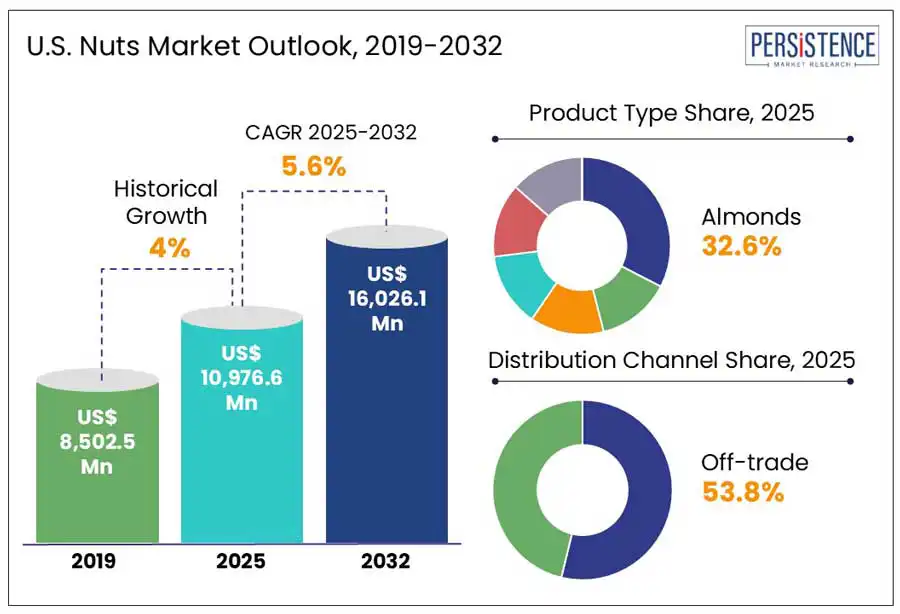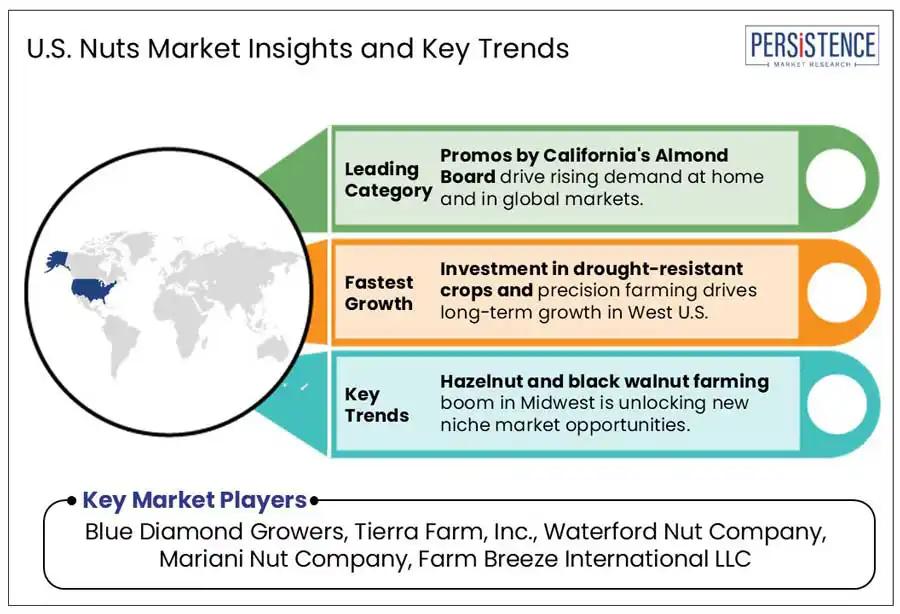Comprehensive Snapshot for U.S. Nuts Market Including Zone and Segment Analysis in Brief.
Industry: Food and Beverages
Published Date: April-2025
Format: PPT*, PDF, EXCEL
Delivery Timelines: Contact Sales
Number of Pages: 140
Report ID: PMRREP35244
The U.S. nuts market size is projected to rise from US$ 10,976.6 Mn in 2025 to US$ 16,026.1 Mn by 2032. It is anticipated to witness a CAGR of 5.6% during the forecast period from 2025 to 2032.
The increasing vegan population in the U.S. is predicted to spur demand for plant-based protein diets. As nuts are mainly considered an ideal alternative to eggs and fish for fulfilling vitamin B12, and calcium requirements, these are expected to gain momentum. Almonds have recently gained traction in the country due to their diabetic-friendly properties such as their low-fat content. Rising popularity of healthy snacking is another key factor estimated to create new opportunities in the market.

Key Industry Highlights
|
Market Attribute |
Key Insights |
|
U.S. Nuts Market Size (2025E) |
US$ 10,976.6 Mn |
|
Market Value Forecast (2032F) |
US$ 16,026.1 Mn |
|
Projected Growth (CAGR 2025 to 2032) |
5.6% |
|
Historical Market Growth (CAGR 2019 to 2024) |
4.0% |
The U.S. nuts market growth will likely be propelled by the rising snacking trend. Today’s consumers are increasingly shifting to snacks from conventional meals. As per a survey, in 2024, around 17% of individuals in the country reported replacing their meals with snacks, up from 14% in 2023. This rapid shift is projected to be boosted by high demand for convenient yet nutritious options and busy lifestyles. Nuts, being rich in healthy fats and protein, are ideal for making different types of snacks such as protein bars, cookies, and trail mixes.
Brands such as Blue Diamond have already capitalized on this trend by launching flavored almonds in convenient packaging to attract millennials and Gen Z consumers. The rapid integration of snacks into meals is also becoming common in the U.S. Consumers are incorporating nuts into yogurts and salads due to their high versatility.
Nut allergies, especially to tree nuts and peanuts, are considered a prominent factor limiting demand in the U.S. to a certain extent. Tree nut allergies, which include nuts such as pistachios, cashews, almonds, and walnuts, affect around 0.5% to 1% of the total U.S. population. Peanut allergies, on the other hand, affect nearly 2.5% of children in the country. These allergies tend to persist into adulthood, with several individuals unable to outgrow them.
Individuals living with nut allergies are recommended to avoid all forms of nuts, including those used in oils, flavorings, baked goods, and processed food items. Due to the extensive use of nuts in a wide variety of food and beverages, careful labeling is required. In addition, limiting food options will likely result in a decline in the total amounts of nuts consumed in the U.S.
Ongoing expansion of domestic nut farming is speculated to open the door to new opportunities in the U.S. through 2032. In California, for example, almond production was predicted at 2.80 Bn pounds in 2024 alone, which was a 13% surge from 2.47 Bn pounds in 2023. This is mainly due to improved yields and favorable weather conditions, with the average yield per acre increasing to 2,170 pounds in 2024 from 1,790 pounds in 2023, finds a new report.
Pistachio farming is further showcasing steady growth, with the total harvest in the U.S. reaching a record 1.5 Bn pounds in 2023. A few experts estimate that in the next few years, pistachio production in the country will surpass 2 Bn pounds, encouraging innovations in product processing and adoption of marketing strategies.
Increasing shift of consumers toward clean-label and organic products is a leading trend in the U.S. Clean-label nuts free from preservatives and artificial additives are showcasing considerable growth due to surging health consciousness among modern consumers. They are striving to move away from products containing synthetic ingredients.
Rising prevalence of heart diseases and diabetes in the U.S. is another important factor spurring nuts demand. Several clinical studies have proved that nut consumption on a daily basis can help reduce Low-Density Lipoprotein (LDL) cholesterol and lower the risk of cardiovascular diseases. Various local health organizations such as the American Heart Association, for instance, have promoted nuts as part of a healthy diet, boosting their demand in the U.S.
Based on type, the market is segmented into almonds, peanuts, pistachios, walnuts, and cashew. Out of these, almonds are speculated to generate a share of nearly 32.6% in 2025, says Persistence Market Research. This is attributed to their rising integration into functional snacks, plant-based food, and health-focused diets. In the U.S., almonds were the most consumed tree nut as of 2024, revealed the U.S. Department of Agriculture (USDA), with per capita consumption reaching around 2.4 pounds per person. As almonds are rich in unsaturated fats, fiber, protein, and vitamin E, their use is predicted to rise in heart-healthy food items.
Peanuts, on the other hand, are likely to exhibit a steady CAGR through 2032 due to their widespread availability and high affordability, making these a staple in regular diets. As per studies, in 2024, per capita consumption of peanuts in the U.S. reached 7.3 pounds. Peanuts are also extensively used in the preparation of peanut butter. Increasing demand for protein-rich and convenient food options is expected to spur demand for peanut butter in the country.
In terms of distribution channel, the market is bifurcated into on-trade and off-trade. The off-trade channel is projected to hold about 53.8% of the U.S. nuts market share in 2025. Off-trade channels provide consumers with the ability to buy nuts at their convenience, without the requirement of visiting eateries or specialized stores. Supermarkets and hypermarkets offer a wide range of products, from roasted and raw to mixed and flavored options, catering to evolving consumer demands. This variety and accessibility will likely make off-trade channels an ideal choice for busy consumers.
On-trade channels, on the other hand, are expected to showcase decent growth through 2032. Restaurants and chefs are increasingly incorporating nuts into main dishes, baked products, and salads to improve nutritional value and flavor profile. This trend is associated with the rising interest of modern consumers in health-conscious dining options. Foodservice companies are further offering nut-based options to cater to the rising demand for plant-based menus.

West U.S. is expected to account for a share of around 33.7% in 2025. In this zone, California is anticipated to remain a key hub for nuts production. The state produces around 80% of the world's supply of almonds. Pistachios have also emerged as a significant growth area in the state. These are highly valued for their ability to grow in saline soils and superior drought tolerance, making them a sustainable option compared to other nuts.
California’s pistachio exports reached 390,000 metric tons in 2023, accounting for 70% of global exports. Walnut production in California, however, experienced fluctuations owing to changing market dynamics and international competition. Almond cultivation also involves intensive water use, which will likely contribute to concerns about environmental impact and sustainability.
In Southeast U.S., Georgia continues to be a leading producer of pecans, contributing around 42% of the total national output in 2023. The state houses more than 223,000 acres of pecan orchards, ranging from large-scale commercial operations to small family farms. Its favorable soil and climate conditions have traditionally made Georgia a suitable state for pecan cultivation.
Institutions such as the University of Georgia offer support to pecan cultivators through extension services and thorough research activities. These focus on discovering new practices for post-harvest handling, pest management, and cultivation. Such efforts are poised to play a key role in improving sustainability and productivity in the state’s pecan industry.
In Midwest U.S., states such as Iowa, Wisconsin, and Minnesota are constantly exploring hazelnut cultivation. Research institutions such as the University of Wisconsin and the University of Minnesota, for example, are focusing on coming up with cold-hardy hazelnut varieties ideal for this zone. Such initiatives aim to offer farmers alternative crops that can provide both environmental and economic benefits.
Missouri, on the other hand, dominates in terms of black walnut production. Black walnuts are mainly valued for their high versatility and novel flavor profile. These are often incorporated in several main dishes. The crop is considered well-suited for the soil and climate conditions of Midwest U.S., making it a valuable option for domestic production.
The U.S. nuts market is highly competitive with the presence of several large-scale and start-up companies. Leading companies are focusing on new product launches to cater to varying demands of consumers. They are constantly bringing in innovation in terms of product usage, variety, and quality to maintain a strong presence. Start-up firms are striving to market their products by launching convenient and sustainable packaging of nuts to attract new consumers.
|
Report Attribute |
Details |
|
Historical Data/Actuals |
2019 - 2024 |
|
Forecast Period |
2025 - 2032 |
|
Market Analysis Units |
Value: US$ Bn/Mn, Volume: As Applicable |
|
Geographical Coverage |
|
|
Segmental Coverage |
|
|
Competitive Analysis |
|
|
Report Highlights |
|
|
Customization and Pricing |
Available upon request |
By Product Type
By Distribution Channel
By Zone
To know more about delivery timeline for this report Contact Sales

The market is projected to be valued at US$ 10,976.6 Mn in 2025.
Increasing incorporation of nuts in various snacking items and rising shift of individuals toward plant-based diets are the key market drivers.
The market is poised to witness a CAGR of 5.6% from 2025 to 2032.
Surging investments by key players in domestic nut farming and the launch of clean-label products are the key market opportunities.
Blue Diamond Growers, Tierra Farm, Inc., and Waterford Nut Company are a few key market players.